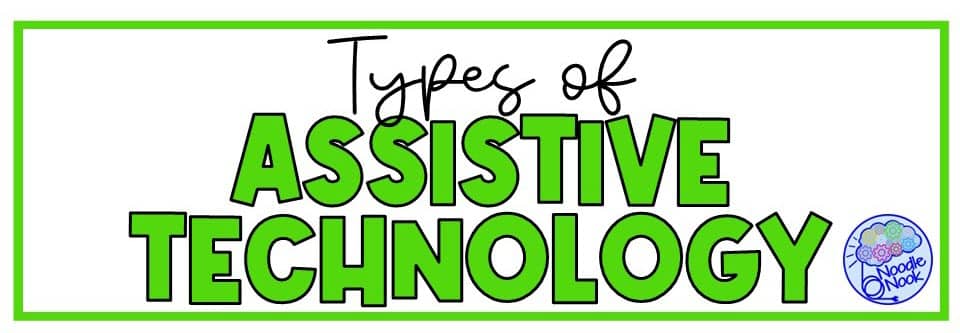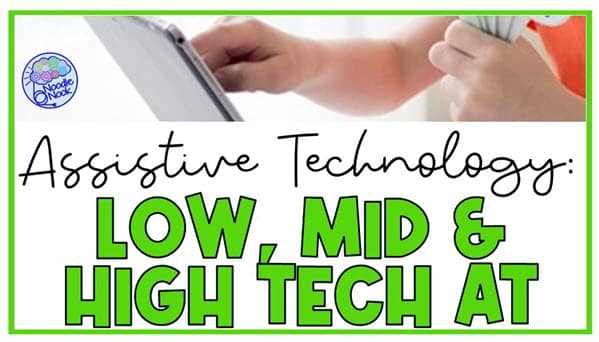Assistive technology refers to any device or software that is designed to help individuals with disabilities more fully participate in their daily lives and activities. While most people think of computer-aided tools, like text-to-speech software or robotic devices when they think of technology tools these days, that’s not really accurate. There are lots of low, mid and high-tech assistive technology options!
In the educational setting, assistive tech. or AT, are tools for supporting students with disabilities to learn, have access, or be more independent. In other words, AT tools are used to help the student fully participate in the classroom and during activities in the least restrictive environment, as opposed to being placed in a separate or segregated setting.
Here are a few examples of low, mid and high-tech assistive technology with ways they can be used to support students with disabilities in the least restrictive environment:
Low-Tech AT Tools in Special Ed
Low-tech tools for assistive technology are simple, low-cost tools that can help individuals with disabilities more fully participate in their daily lives and activities. These tools often do not require electricity or complex technology and can be used in a variety of settings.
Here are a few examples of low-tech tools for assistive technology:
Adaptive pencil grips:
These are rubber or plastic grips that are placed on a pencil or pen to make it easier for individuals with limited hand strength or mobility to hold and use the writing implement.
Magnifiers:
These are lenses or other devices that can be used to enlarge text or images, making them easier to see and read.
Communication boards:
These are boards with pictures or words that can be used by individuals who are unable to speak or have difficulty communicating to express their wants and needs.
Adaptive utensils:
These are utensils, such as spoons or forks, that have been modified to be easier for individuals with limited hand strength or mobility to use.
Adaptive clothing:
This includes clothing items that have been modified or designed specifically to be easier for individuals with disabilities to put on and take off, such as clothing with Velcro closures or easy-to-reach buttons.
Overall, low-tech tools for assistive technology can be an effective and affordable way to support individuals with disabilities in their daily lives and activities.
Mid-Tech AT Tools in Special Ed
Mid-tech assistive technology refers to tools and devices that are more technologically advanced than low-tech tools but do not require a high level of technical expertise or significant investment to use. These tools often require electricity or some form of computer technology to function but are still relatively simple and easy to use.
Here are a few examples of mid-tech assistive technology:
Communication devices:
These are electronic devices that allow individuals who are unable to speak or have difficulty communicating to express their wants and needs. Examples might include electronic communication boards or devices with synthesized speech.
Switch-operated toys and devices:
These are toys or other devices that can be operated by pressing a switch, which can be helpful for individuals with physical disabilities who have difficulty using their hands or fingers.
Adaptive keyboards and mice:
These are computer keyboards and mice that have been modified or designed to be easier for individuals with physical disabilities to use.
Electronic notetakers:
These are portable devices that allow individuals to take notes, write down ideas, or create simple documents using a keyboard or other input methods.
Text-to-speech software:
This type of software reads text aloud, which can be helpful for individuals who have difficulty reading or processing written text.
Overall, mid-tech assistive technology can be an effective way to support individuals with disabilities in their daily lives and activities and can provide more advanced or specialized support than low-tech tools.
READ MORE! Read about these related topics: The Prompting Hierarchy and Using Assistive Technology
High-Tech AT Tools in Special Ed
High-tech assistive technology refers to tools and devices that are highly sophisticated and require a high level of technical expertise or significant investment to use. These tools often involve complex computer technology or specialized equipment and are typically used to provide very advanced or specialized support to individuals with disabilities.
Here are a few examples of high-tech assistive technology:
Augmentative and alternative communication (AAC) devices:
These are electronic devices that allow individuals who are unable to speak or have difficulty communicating to express their wants and needs using synthesized speech or other communication methods.
Brain-computer interfaces:
These are devices that allow individuals to control a computer or other device using their thoughts or brain activity.
Virtual reality systems:
These are computer systems that allow individuals to experience simulated environments and interact with them in a realistic way.
Robotic assistive devices:
These are devices that use robotics technology to help individuals with physical disabilities perform tasks or move around.
Smart home technology:
This includes devices and systems that allow individuals to control and automate various aspects of their home environment, such as lighting, temperature, and security, using a smartphone or other device.
Overall, high-tech assistive technology can provide very advanced or specialized support to individuals with disabilities, and can help them more fully participate in their daily lives and activities. However, these tools often require significant investment and may require specialized training or technical expertise to use.
How to Implement AT Tools for Students with Disabilities
There are a few key steps to implementing assistive technology (AT) tools in the classroom for students with significant disabilities:
Identify the student’s needs:
The first step in implementing AT tools in the classroom is to identify the specific needs and goals of the student. This may involve working with the student, their parents or caregivers, and other professionals such as an occupational therapist or speech therapist to determine what types of AT tools might be most helpful.
Research and evaluate AT options:
Once the student’s needs have been identified, the next step is to research and evaluate different AT options that might meet those needs. This may involve consulting with AT specialists, reviewing research and studies on different tools, and considering the student’s preferences and interests.
Implement and train:
Once the appropriate AT tools have been identified, the next step is to implement and train the student and their teacher on how to use the tools effectively. This may involve providing training and support to the teacher on how to use the tools in the classroom, as well as providing training and support to the student on how to use the tools to achieve their goals.
Monitor and adjust:
It is important to regularly monitor the student’s progress and adjust the AT tools as needed to ensure that they are meeting the student’s needs and helping them achieve their goals. This may involve working with the student, their teacher, and other professionals to make any necessary adjustments to the tools or the student’s education plan.
Recap: Implementing AT Tools in Special Ed
Overall, implementing AT tools in the classroom for students with significant disabilities requires careful planning, evaluation, and ongoing monitoring to ensure that the tools are being used effectively and are meeting the student’s needs. Whether you’re using the low, mid, or high-tech assistive technology tools, make sure they support a student’s access and you’re explicitly teaching how to use it. This will help a student be most successful with their assistive technology.
Recap: Assistive Tech in Special Ed
In special education, low, mid and high-tech assistive technology can be a powerful tool for supporting students with disabilities to be more successful in the classroom and also prepare them for life after graduation. Mastering these tools helps them achieve their goals and overcome challenges specific to their disabilities.
There are many different types of AT tools that can be used in special education, including low-tech, mid-tech, and high-tech tools. To effectively implement AT tools in special education, it is important to identify the specific needs and goals of the student, research and evaluate different AT options, provide training and support to the student and their teacher on how to use the tools, and regularly monitor and adjust the tools as needed.
Overall, low, mid and high-tech assistive technology options should be something you consider as part of the IEP process for your students. They can make a profound difference in their lives now and in the future.
Article Citation: [cite]


